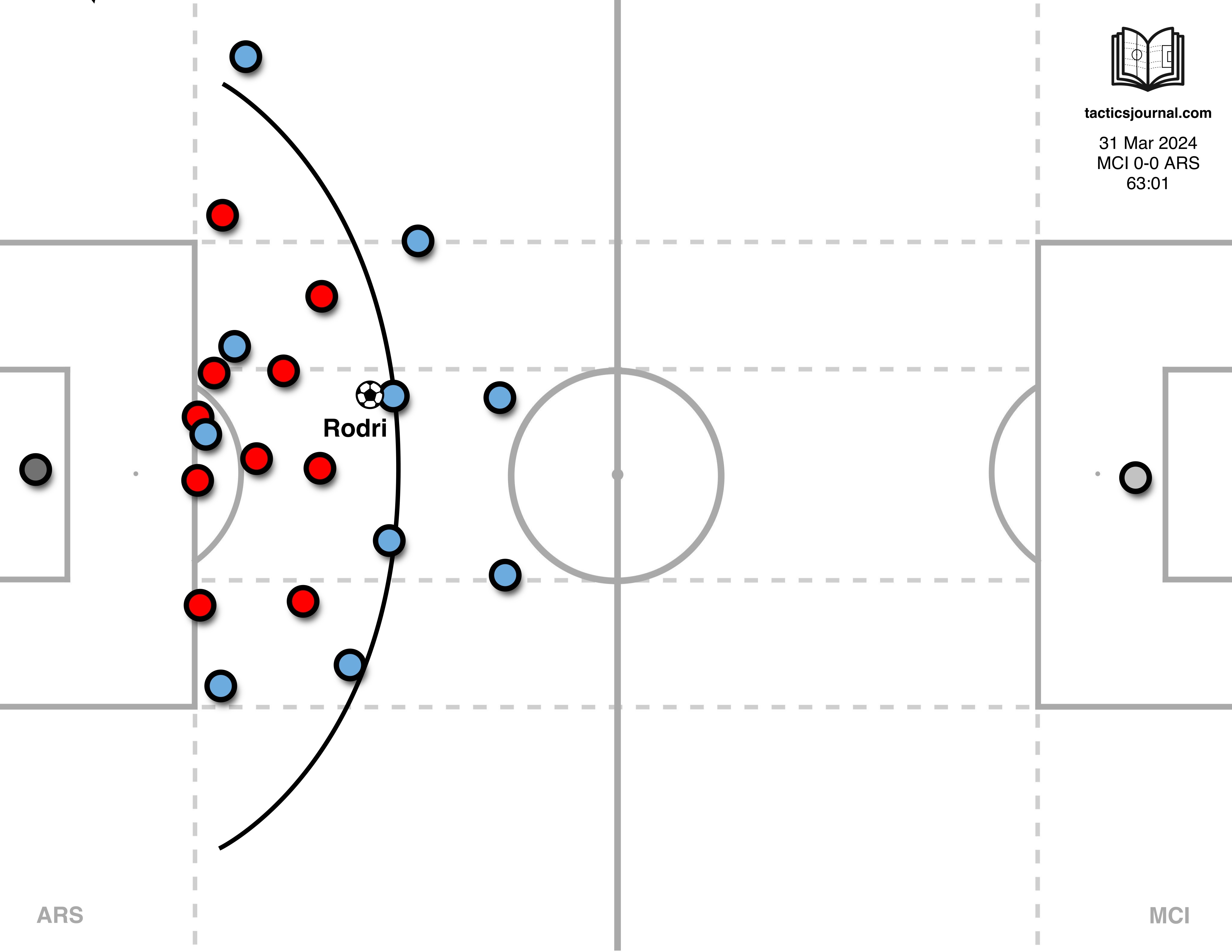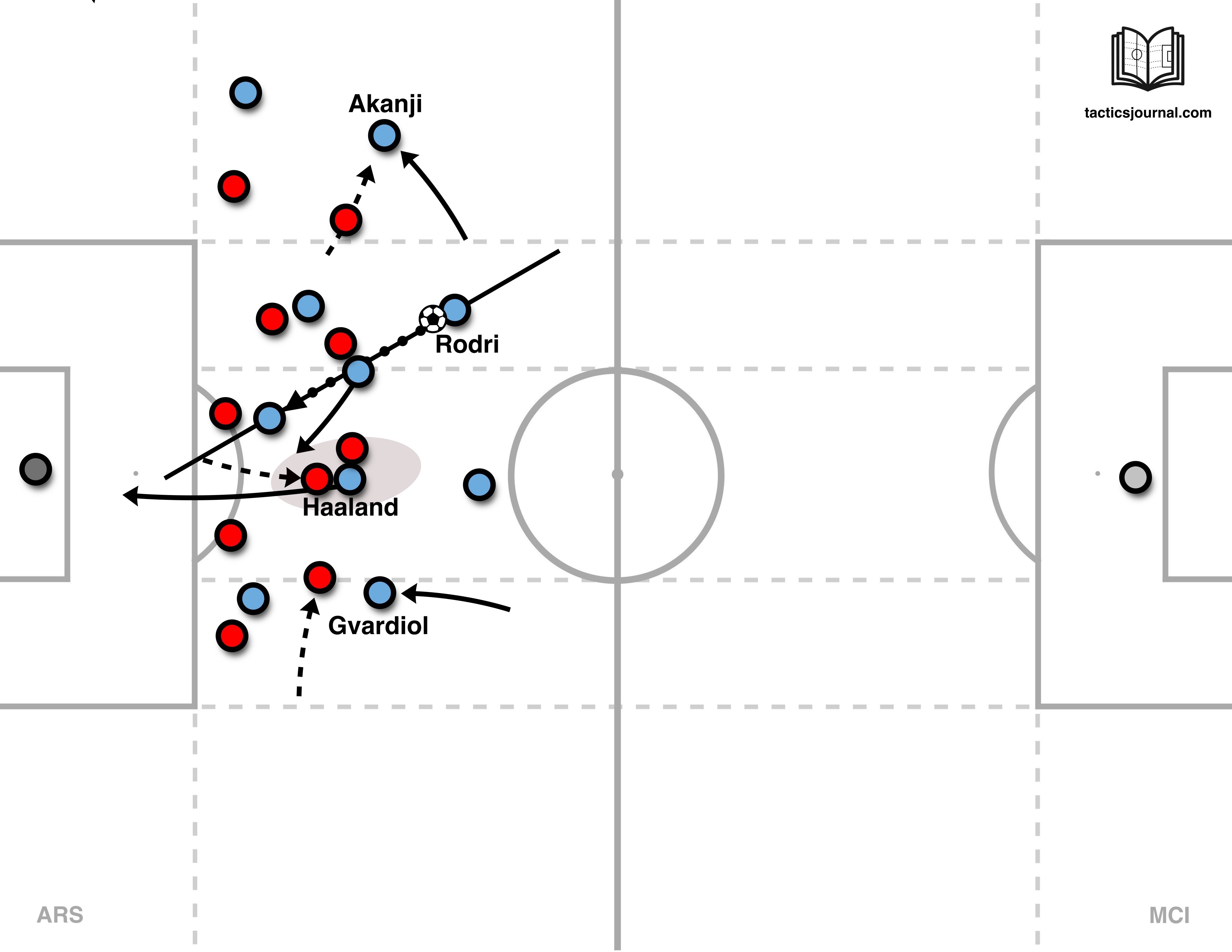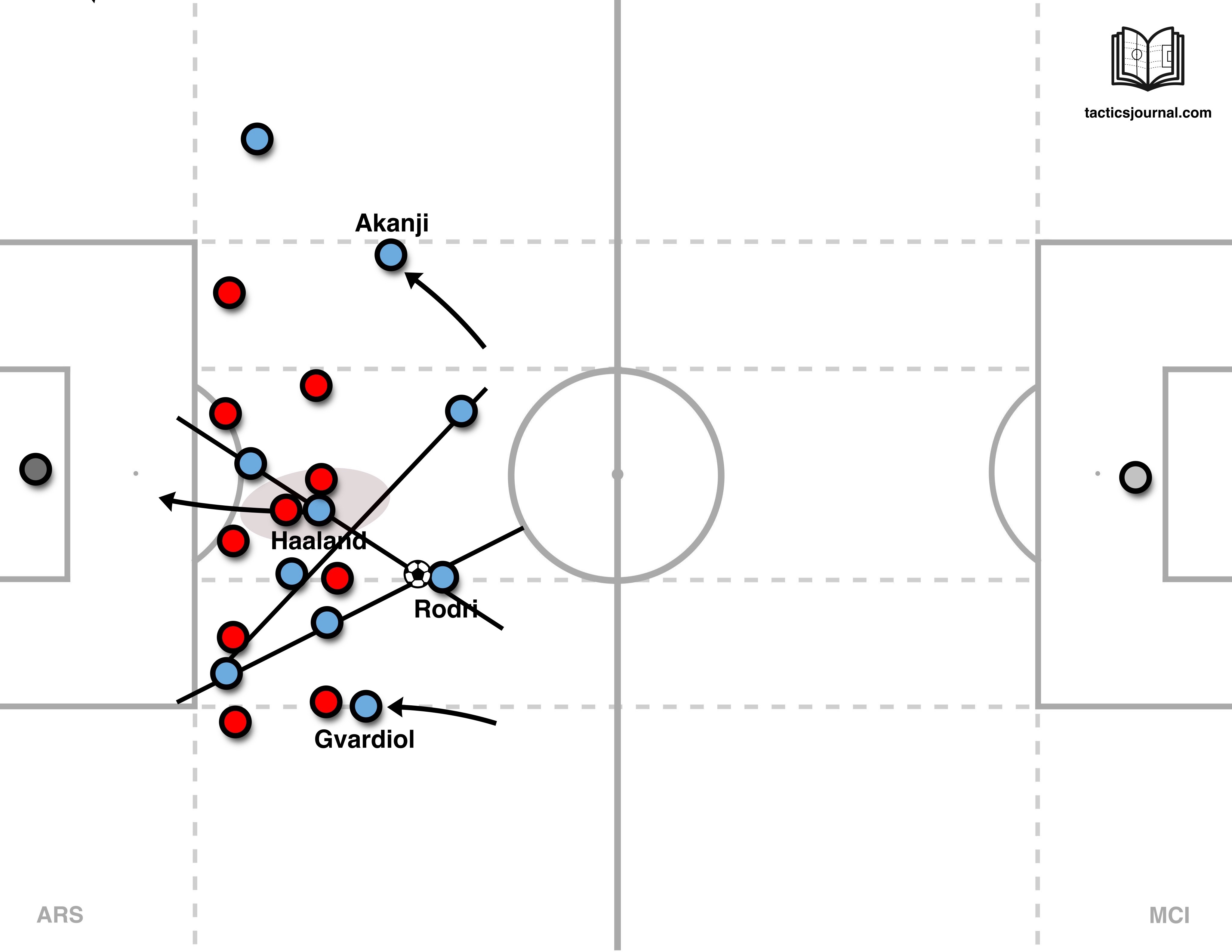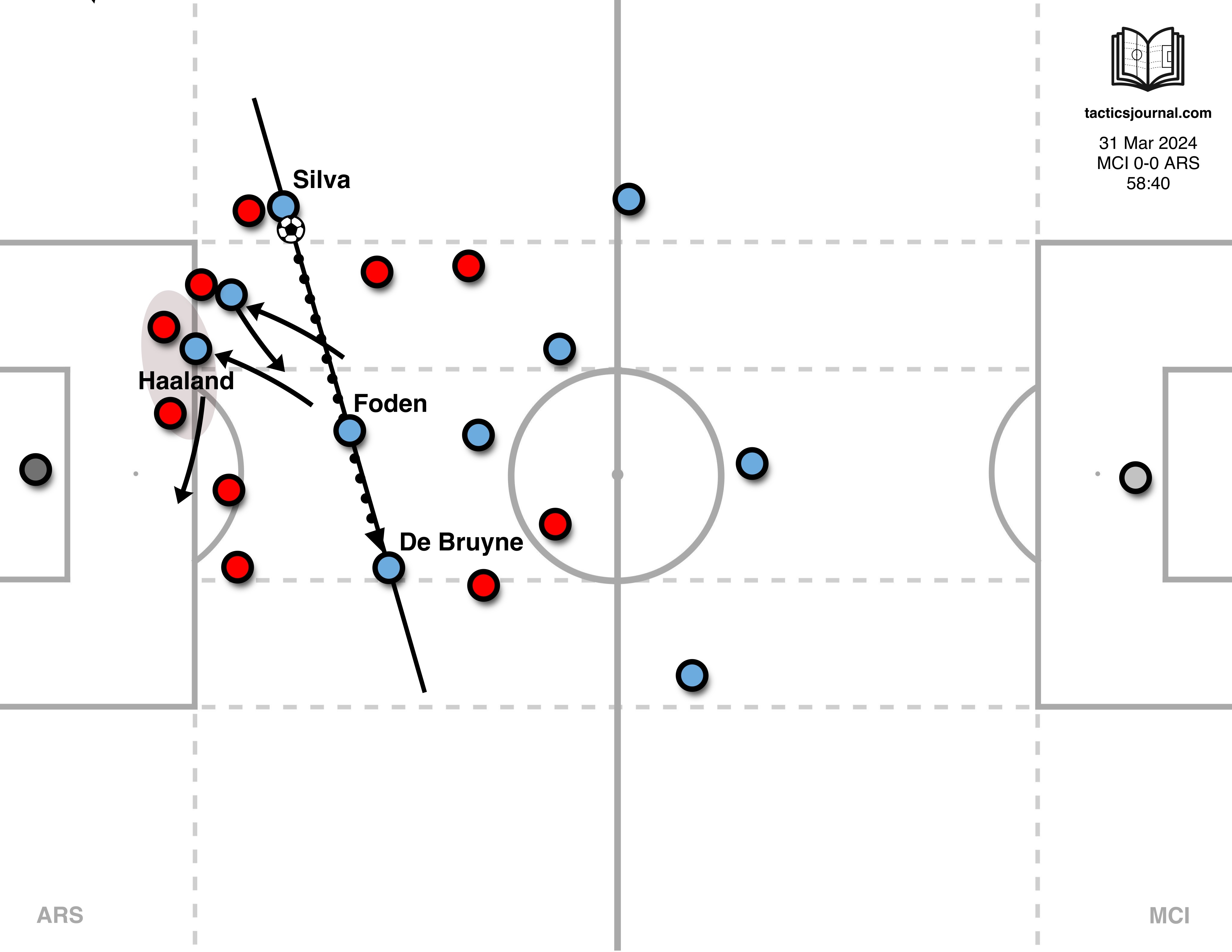How Manchester City should break down Arsenal's low block on the diagonal
22 September 2024
The last time Manchester City played Arsenal at the Etihad, they had a lot of possession but no progression. To break down Arsenal’s deep defensive structure, I think they have to actively arrange themselves to utilize the diagonals way more.

When you look at Manchester City’s structure in that last meeting, you’ll see a horseshoe shape on the perimeter of Arsenal’s defense. They surround them, but they don’t have avenues into the box. The middle is impenetrable.
They can maintain possession, but they will have to work the ball through the wings in the corners to get the ball into the box or be forced to take shots from outside the box. When they work the ball through corners, it becomes an aerial battle, and Arsenal will always win the aerial battles against Manchester City.
Rarely did you see three players align diagonally in that last match. Each set of two players in close proximity were isolated from the rest. They need that third or fourth player to break out of the smaller spaces.

If City were to focus more on aligning on the diagonal in the middle of the pitch, that would give them more options to deceive defenders. Those one-twos and dummied passes open up when three or more players align diagonally. You can see great examples of this concept in their match against Chelsea last season.
First, manipulate Arsenal’s structure by varying the positioning of City’s outside center-backs Manuel Akanji and Josko Gvardiol to help facilitate the organization of those diagonals.
I think both outside center-backs should remain ahead of Rodri if they can to put pressure on Arsenal’s fullbacks, allowing the wingers to move more freely towards the middle. If the wingers are responsible for pinning the fullbacks, they would have to remain out wide.
One center-back (Gvardiol) should invert slightly to pin an Arsenal outside midfielder inside, and the other center-back (Akanji) should move wider to pin the opposite side’s outside midfielder wide. That will open up space in the right half-space. If both center-backs remain wide simultaneously, that will open up space ahead of Arsenal’s second line, but space will close between their back line and second line.
They should vary who is inverted and who is wide randomly, not have it be based on where the ball is. If they were to, for example, have the far side outside center-back invert and the ball side center-back stay wide, then that would promote that side-to-side passing movement. We don’t want side-to-side; we want to move through the half-spaces.
Second, have Erling Haaland drop to allow someone to occupy the space at the top of City’s attack. Arsenal will double-team him the entire match, with one of either center-backs Gabriel or William Saliba coming out to man-mark him tightly. Haaland doesn’t get a lot of touches, but he has been used previously as a decoy to move either of those defenders, creating space for others.

If they can align diagonally in the center of the pitch, maintaining more adequate numbers to work the ball through Arsenal’s first line of defense, and if Haaland can drop back to the second line to drag a defender with him, that could create opportunities for them to attack that last line from the smaller pockets with Haaland running into the box, well off the ball, at speed.

The diagnoals are important when they break out also. If City gets an opportunity like this again, they need to take it. Haaland drags the defenders deep into Arsenal’s box by making a run into the box. Bernardo Silva plays that pass to Phil Foden; it drags a defender out, and then they have space to combine and work the ball into the box.
It shouldn’t be predictable, but when three players align, they should attempt to play through the diagonal. They should be looking for it first.
Work the ball quickly and if needed, horizontally like Bayern Munich, to open space in the middle.
Manchester City manager Pep Guardiola in his pre-match press conference:
I am concerned how we can do better and create more chances when teams defend so, so deep. This is my dream. Teams that defend eight or nine players in the box, like Real Madrid and Inter Milan, and against Arsenal it’s going to happen.
This is every team’s dream when the opponent believes they have to defend deep. Arsenal don’t have to defend deep, they choose to. How to consistently break a low block down is one of modern football’s unsolved puzzles.
2025
December
- 7th
- 3rd
November
- 29th
- 24th
- 20th
- 14th
- 12th
- 8th
- 7th
- 4th
- 2nd
October
- 31st
- 28th
- 22nd
- 20th
- 19th
- 12th
September
- 30th
- 28th
- 26th
- 24th
- 23rd
- 20th
- 18th
- 16th
- 14th
- 4th
- 3rd
- 1st
August
- 28th
- 27th
- 26th
- 25th
- 24th
- 23rd
- 20th
- 17th
- 14th
- 12th
- 10th
- 8th
- 4th
July
- 10th
- 5th
- 4th
June
- 29th
- 14th
- 13th
- 12th
- 2nd
May
- 29th
- 25th
- 22nd
- 20th
- 15th
- 8th
April
- 30th
- 9th
March
- 28th
- 5th
February
- 26th
- 20th
- 19th
- 12th
- 8th
January
- 31st
- 30th
- 16th
- 12th
- 9th
- 8th
- 7th
- 6th
- 5th
- 4th
- 3rd
- 2nd
- 1st
2024
December
- 31st
- 30th
- 29th
- 28th
- 27th
- 26th
- 25th
- 24th
- 23rd
- 22nd
- 21st
- 20th
- 19th
- 18th
- 17th
- 16th
- 15th
- 14th
- 13th
- 12th
- 11th
- 10th
- 9th
- 8th
- 7th
- 6th
- 5th
- 4th
- 3rd
- 2nd
- 1st
November
- 30th
- 29th
- 28th
- 27th
- 26th
- 25th
- 24th
- 23rd
- 22nd
- 21st
- 20th
- 19th
- 18th
- 18th
- 16th
October
- 21st
- 12th
- 11th
- 9th
- 7th
- 6th
- 4th
- 3rd
- 2nd
- 1st
September
- 30th
- 29th
- 27th
- 26th
- 25th
- 24th
- 23rd
- 22nd
- 21st
- 20th
- 19th
- 18th
- 17th
- 16th
- 15th
- 14th
- 13th
- 12th
- 11th
- 10th
- 9th
- 8th
- 7th
- 6th
- 5th
- 4th
- 4th
- 3rd
- 2nd
- 1st
August
- 31st
- 30th
- 29th
- 28th
- 27th
- 26th
- 25th
- 25th
- 24th
- 23rd
- 22nd
- 21st
- 20th
- 20th
- 19th
- 19th
- 18th
- 17th
- 16th
- 15th
- 14th
- 14th
- 13th
- 12th
- 11th
- 10th
- 9th
- 8th
- 7th
- 7th
- 6th
- 5th
- 4th
- 3rd
- 2nd
- 1st
July
- 31st
- 30th
- 29th
- 28th
- 27th
- 26th
- 25th
- 24th
- 23rd
- 22nd
- 21st
- 20th
- 19th
- 18th
- 17th
- 16th
- 15th
- 15th
- 14th
- 13th
- 11th
- 10th
- 9th
- 8th
- 7th
- 6th
- 5th
- 4th
- 3rd
- 2nd
- 1st
June
- 30th
- 29th
- 28th
- 27th
- 26th
- 25th
- 24th
- 23rd
- 22nd
- 21st
- 20th
- 19th
- 18th
- 17th
- 16th
- 15th
- 14th
- 13th
- 12th
- 11th
- 10th
- 9th
- 8th
- 7th
- 6th
- 5th
- 4th
- 3rd
- 2nd
- 1st
May
- 31st
- 30th
- 29th
- 28th
- 27th
- 26th
- 25th
- 24th
- 23rd
- 22nd
- 21st
- 20th
- 20th
- 19th
- 18th
- 17th
- 16th
- 15th
- 14th
- 13th
- 12th
- 11th
- 10th
- 9th
- 8th
- 7th
- 6th
- 5th
- 4th
- 3rd
- 2nd
- 1st
April
- 30th
- 29th
- 28th
- 27th
- 26th
- 25th
- 24th
- 23rd
- 22nd
- 21st
- 20th
- 19th
- 17th
- 16th
- 15th
- 14th
- 13th
- 12th
- 11th
- 10th
- 9th
- 8th
- 7th
- 6th
- 5th
- 3rd
- 2nd
- 1st
March
- 31st
- 30th
- 29th
- 28th
- 27th
- 26th
- 25th
- 24th
- 23rd
- 21st
- 20th
- 19th
- 18th
- 17th
- 16th
- 15th
- 14th
- 13th
- 12th
- 11th
- 10th
- 9th
- 8th
- 7th
- 6th
- 5th
- 4th
- 3rd
- 1st
February
- 28th
- 27th
- 26th
- 25th
- 23rd
- 22nd
- 21st
- 20th
- 18th
- 15th
- 14th
- 13th
- 12th
- 11th
- 8th
- 7th
- 6th
- 5th
- 4th
- 3rd
- 2nd
- 1st
January
- 31st
- 30th
- 29th
- 28th
- 27th
- 25th
- 24th
- 22nd
- 21st
- 20th
- 18th
- 17th
- 16th
- 15th
- 14th
- 13th
- 12th
- 11th
- 9th
- 8th
- 7th
- 6th
- 5th
- 4th
- 3rd
- 2nd
- 1st
2023
December
- 31st
- 29th
- 28th
- 27th
- 25th
- 24th
- 22nd
- 21st
- 20th
- 19th
- 18th
- 17th
- 16th
- 15th
- 13th
- 12th
- 11th
- 10th
- 8th
- 7th
- 6th
- 4th
- 3rd
- 2nd
- 1st
November
- 30th
- 29th
- 28th
- 27th
- 26th
- 25th
- 24th
- 23rd
- 22nd
- 21st
- 20th
- 18th
- 17th
- 16th
- 15th
- 14th
- 13th
- 12th
- 11th
- 10th
- 9th
- 8th
- 7th
- 6th
- 5th
- 4th
- 3rd
October
- 31st
- 30th
- 29th
- 27th
- 26th
- 25th
- 24th
- 23rd
- 22nd
- 19th
- 17th
- 15th
- 14th
- 13th
- 12th
- 11th
- 10th
- 9th
- 8th
- 7th
- 6th
- 5th
- 4th
- 1st
September
- 30th
- 28th
- 26th
- 25th
- 24th
- 22nd
- 21st
- 20th
- 19th
- 18th
- 17th
- 9th
- 3rd
August
- 31st
- 28th
- 27th
- 26th
- 21st
- 20th
- 15th
- 14th
- 13th
- 12th
- 7th
- 4th
- 3rd
July
- 31st
- 30th
- 28th
- 27th
- 25th
- 24th
- 23rd
- 22nd
- 21st
- 20th
- 19th
- 18th
- 17th
- 16th
- 15th
- 14th
- 13th
- 12th
- 11th
- 10th
- 9th
- 8th
- 7th
- 6th
- 5th
- 4th
- 3rd
June
- 11th
- 10th
- 7th
- 5th
- 4th
- 1st
May
- 28th
- 27th
- 26th
- 25th
- 24th
- 23rd
- 22nd
- 21st
- 20th
- 19th
- 18th
- 17th
- 16th
- 15th
- 14th
- 13th
- 11th
- 10th
- 9th
- 8th
- 7th
- 5th
- 4th
- 3rd
- 2nd
- 1st
April
- 29th
- 28th
- 27th
- 26th
- 25th
- 24th
- 23rd
- 22nd
- 22nd
- 21st
- 20th
- 2nd
March
- 6th
February
- 27th
- 20th
- 5th
January
- 19th
